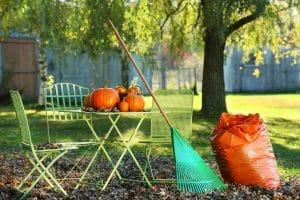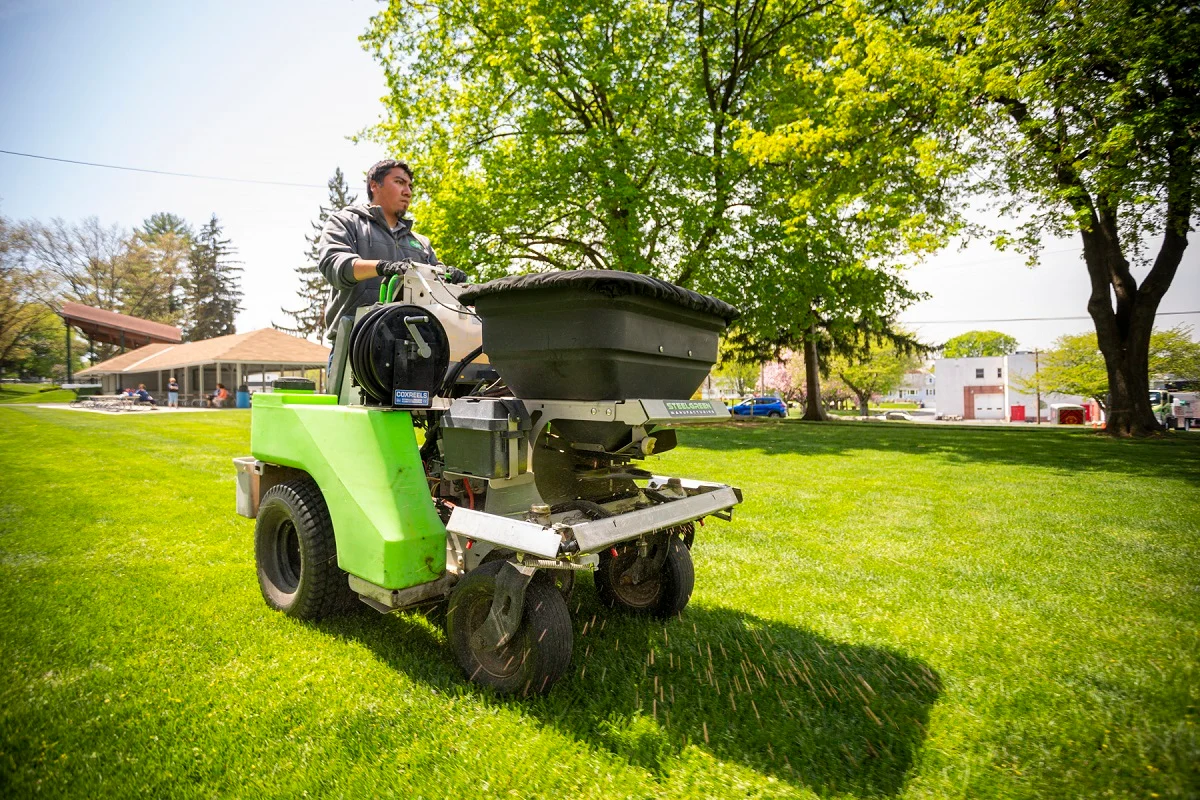What Is the Best Time to Apply Fall Fertilizer?
Last Updated on November 6, 2025 by Duncan
As a homeowner, you may have the impression that spring and summer are the best times to fertilize your lawn, but this is not the case, as your lawn is bound to benefit significantly from supplemental fertilizer in the fall.
Fertilizing during the off-season will strengthen the roots of your lawn, providing them with a solid foundation on which to grow the following spring.
What is the best time to apply fall fertilizer?
The right time to apply fall fertilizer depends on your environment and the type of grass in your yard. Warm-season grasses are common in the South, cool-season grasses in the North, and a combination of the two in the middle.
These different varieties of grasses have distinct growing seasons, so it’s critical to understand which you have.
Warm-season grasses such as bahiagrass, bermudagrass, and St. Augustine grass become dormant in the winter and resume growth in late spring. Their growing cycle extends throughout the summer and into the fall.
You can fertilize these grasses throughout the growing season, although the optimal times to apply the fertilizer are late spring or early summer, followed by mild fertilization in early fall (September).
If your warm-season lawn needs a fall touch-up, keep it light and early; fertilize no later than early to mid-September. Anything later means nutrients will not be absorbed, and weeds may gain an edge.
To be on the safe side, do a soil test, which will help you reveal exactly what you need. Some warm-season grasses, such as Bermuda, often do not require nitrogen in the fall. Apply only what your results require, and avoid high-N products late in the season.
Cool-season grasses, such as tall and fine fescue and Kentucky bluegrass, go dormant during the hottest months of the summer. They cease developing and may wilt, but will recover once the weather cools.
These grasses may begin to develop in the late winter, but by early summer, they will have flowered and set seed. Cool-season grasses can handle more fertilizer until late fall, when plants prepare for winter dormancy (September, October, and possibly November).
Special winter fertilizer may provide further cold-weather protection; use it after you mow the lawn for the final time this season.
The rule of thumb with these grasses is simple: feed them while the grass is actively growing, not when it is slowing or dormant. As mentioned, cool-season grasses are actively growing in the fall, making it the optimal time to fertilize.
Ideally, apply fall fertilizer 6 to 8 weeks before the first forecast frost to allow roots to absorb nutrients, repair summer stress, and store energy for the winter. In many locations, this occurs in September.
If you missed that window, you can fertilize until November, but the advantages will decrease as the soil cools.
You can time fall fertilizing by the soil temperature
Soil temperature refers to how warm the ground is a few inches beneath the surface, averaged over several days. It is not equivalent to the current air temperature. The soil temperature can help you choose the optimal time to fertilize your lawn:
For the cool-season grasses, fertilize them when the soil temperature is between 55 and 75 degrees Fahrenheit. Hold off if your results are already below that range.
When it comes to warm-season grasses, fertilize when the soil temperature ranges from 60 to 85 degrees F. If you missed out on summer, early October is your last chance to take advantage of warm soils.
Below 40 degrees Fahrenheit, roots are generally inactive and cannot absorb nutrients efficiently; therefore, fertilizer is wasted.
Why fall fertilizing matters
Fall not only marks the end of one growing season, but also the beginning of another. It’s critical for you as a homeowner to help your lawn store energy before the cold weather arrives. A well-timed fertilizer application helps achieve ideal results when spring arrives.
The benefits of fall fertilizer include:
- Allows grass to grow deeper, denser roots before the ground freezes.
- Increases nutritional reserves for optimal spring development.
- Increases your lawn’s resilience to snow mold and cold damage.
- Encourages rapid green-up after the snow melts.
- Reduces patchiness and bare patches in the early spring.
- Improves the general health of cool-season grass
Overall, applying fall fertilizer is similar to feeding your lawn a nutritious supper before a long rest.
How to apply fall fertilizer
Fall fertilizing is only effective if you apply it at the right time, with the right product, and in the correct manner. A few tiny errors can result in wasted labor or possibly lawn damage. Thankfully, when done correctly, it’s one of the most effective ways to safeguard and prepare your lawn.
Do it at the right time
Timing is everything. If you fertilize too early, your lawn may produce new growth that cannot withstand the winter. Too late, and the ground will be too cold for nutrients to reach the roots.
Fertilize in early to mid-fall, while the soil is still warm enough to absorb nutrients. The best time to install windows is between mid-September and the third week in October.
A safe time frame is 4 to 6 weeks before the first heavy frost. To make an informed decision, consult local frost calendars or average temperature trends.
It goes without saying that a soil thermometer comes in handy. Fertilizing at soil temperatures ranging from 55°F to 65°F gives roots the best possible opportunity of absorbing nutrients.
Work with the right fertilizer.
Different fertilizers work differently. For the fall, you’ll want a blend that encourages vigorous root development while limiting leaf growth.
Choose a nitrogen-rich fertilizer (the first number in the N-P-K ratio) with a moderate amount of potassium. Phosphorus is frequently low or missing, unless a soil test indicates that your lawn requires it.
To be on the safe side, look for mixtures like this:
- 20-8-8 provides solid early-fall coverage
- 24-4-12 for lawns recovering from intense summer usage
- If you require a boost near the frost window, use 32-0-10
If you apply the fertilizer in September, use a slow-release formula. If it’s already late October, consider using a quick-release product that absorbs faster before the earth cools entirely.
To be on the safe side, avoid using leftover spring or summer fertilizer. Those mixtures are intended for top growth rather than root health, which your lawn requires as it prepares for winter.
Ensure your lawn is ready for fertilizer.
Preparing the lawn before fertilizing ensures that nutrients enter the soil cleanly. It also helps to minimize runoff and uneven absorption.
Begin by cutting your grass to a medium-short height, which is shorter than in the summer but not scalped. This allows granules to reach the soil’s surface more easily.
You should then:
- Remove the leaves, sticks, and other trash.
- Rake up thatch that is thicker than half an inch.
- Water lightly the day before if your lawn feels dry.
- Make sure the soil is firm and not damp.
- Avoid fertilizing a damp lawn. High moisture levels prevent granules from settling and can increase runoff. And you don’t want this.
Aerating your grass before fertilizing, if you haven’t done so already, might help nutrients go deeper into the soil.
Apply the fertilizer using a spreader.
In order to avoid uneven color or patchy growth in the spring, ensure even coverage. This is why hand-spreading is not suggested for significant areas.
If you have a large, open yard to treat, use a broadcast spreader. If your lawn has tight borders or tiny areas, a drop spreader provides better control.
Before you begin, verify your spreader’s settings to confirm they match the directions on the fertilizer bag. Then, move slowly and steadily, overlapping your passes slightly to maintain even coverage.
To prevent waste and damage, keep at least a foot away from sidewalks, driveways, and flower beds.
After covering the area once, return in the opposite direction to cross-pattern your spread. This fills up the gaps and produces a more balanced output.
Water the lawn lightly.
Watering activates nutrients and moves them into the soil, where roots can absorb them. Skipping this step may result in fertilizer sitting on the surface, increasing the danger of burn.
Gently water the entire grass, just enough to dampen the topsoil but not flood it. A good rule is to aim for roughly a quarter-inch of water.
If rain is forecast within 24 hours, you may not need to water manually; however, this is only true if the rain is light and continuous, rather than sudden.
If you’re unsure how much water to apply, scatter a few empty tuna cans around the yard to evaluate the amount. Stop watering when they reach a quarter inch.
Each of the mentioned steps lays the groundwork for your grass to remain healthy during the winter and grow stronger when spring arrives. So, be diligent with every step.
FAQs
Should I fertilize differently if I am overseeding in the fall?
Yes, there are some things you should do differently if you plan to overseed in the fall. Most fertilizers contain formulations designed for established grass. That implies they may harm grass seedlings that have not yet established themselves.
Here are some timing tips to consider:
- Fertilize with ordinary fertilizer at least four weeks before planting new seeds.
- Do not fertilize or overseed at the same time.
- If you have not fertilized before, wait around 8 weeks after overseeding.
How can I tell whether my grass needs fall fertilizer?
A soil test is the best way to determine whether your grass needs fall fertilizer. It will show you which nutrients your lawn lacks, allowing you to personalize the fertilizer to your specific needs.
Slow growth, a lack of color, and the presence of weeds are all telltale symptoms that your lawn needs fertilizer.
Can I use the same fertilizer for both spring and fall applications?
You can use the same fertilizer, but it is not optimal. The needs of your lawn vary depending on the season, grass variety, and soil.
In the spring, grass emerges from dormancy and benefits from nitrogen fertilization to green up and restart regeneration. In contrast, in the fall, your fertilizer should focus on winter hardiness, which typically includes potassium. Regardless, always check the NPK ratio.


